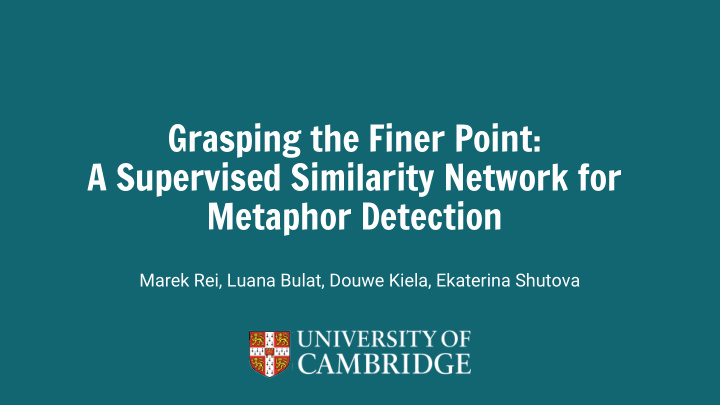



Grasping the Finer Point: A Supervised Similarity Network for Metaphor Detection Marek Rei, Luana Bulat, Douwe Kiela, Ekaterina Shutova
Metaphors in Language Metaphors arise when one concept is viewed in terms of the properties of the other. (Shutova & Teufel, 2010) How can I kill a process? 1. "My heart with pleasure fills , and dances with the daffodils." 2. 3. He attacked every weak point in my argument. The ambassador will start mending foreign policy. 4. They can help explain a concept better, make the reader visualise a concept, and add richness and colour to communication.
Metaphor Detection Helps NLP systems understand the real meaning behind the words. Allows generation systems to generate rich and nuanced natural text. Semantic roles Sparse distributional features • • (Gedigian et al., 2006) (Shutova et al., 2010) • Concreteness • Dense neural word embeddings (Turney et al., 2011) (Bracewell et al., 2014) • Imageability • Visual vectors (Strzalkowski et al., 2013) (Shutova et al., 2016) • WordNet supersenses • Attribute-based vectors (Tsvetkov et al., 2014) (Bulat et al., 2017) We propose a neural architecture that is specially designed for metaphor detection.
Cosine Similarity Shutova et al. (2016) showed that the cosine similarity between neural embeddings of the two words in a phrase is indicative of its metaphoricity. For example would have lower similarity than
Cosine Similarity If the input vectors x1 and x2 are normalised to unit length, the cosine similarity between them is equal to their dot product: We can formulate that as a small neural network: Matrix of ones Single neuron output
Weighted Cosine We can instead create a version where vector m is passed through another layer, with weights that are optimised during training. Matrix of trainable weights Longer vector
Word Representation Gating Example: “healthy balance” The source domain properties of the adjective "healthy” are projected onto the target domain noun “balance”, resulting in the interaction of the two domains in the interpretation of the metaphor. Gating the noun vector, based on the adjective vector.
Vector Space Mapping The original method uses basic pre-trained skip-gram vectors. Let’s add a transformation that maps them into a space that is specific for metaphor detection. Importantly, we will use separate mappings for adjectives and nouns. The weight matrices are optimised during training, while the pre-trained embeddings are kept fixed.
Supervised Similarity Network The final network architecture, using: 1. Word gating 2. Representation mapping Vector combination based on weighted cosine 3.
Optimisation Output between 0 and 1 with sigmoid activation Minimising squared distance with margin 0.1
Word Representations Skip-gram embeddings Attribute vectors Skip-gram with negative sampling Each dimension is a property for the (Mikolov et al., 2013). word (Bulat et al., 2017). 100-dimensional 2526-dimensional Trained on English Wikipedia for 3 Trained on McRae norms, predicted for epochs. missing words. Easy to obtain and generate. Give the best results in previous work.
Datasets TSV - Tsvetkov et al. (2014) MOH - Mohammad et al. (2016) Adjective–noun pairs annotated for Verb-subject and verb-object pairs metaphoricity by 5 annotators. annotated for metaphoricity by 10 annotators. 1768 pairs for training, 200 for testing. 647 pairs, using 10-fold cross-validation Metaphorical Literal Metaphorical Literal deep understanding cold weather absorb cost accommodate guest empty promise dry skin attack problem attack village green energy breathe life empty can deflate mattress healthy balance design excuse gold coin digest milk
Results: Tsvetkov dataset F1 Tsvetkov et al. (2014) 85 Shutova et al. (2016) linguistic 76 Shutova et al. (2016) multimodal 79 Bulat et al. (2017) 77 FFN skip-gram 74.4 FFN attribute 74.5 SSN skip-gram 80.1 SSN attribute 80.6 SSN fusion 81.1
Results: Mohammad dataset F1 Shutova et al. (2016) linguistic 71 Shutova et al. (2016) multimodal 75 FFN skip-gram 70.5 FFN attribute 68.3 SSN skip-gram 74.2 SSN attribute 68.8 SSN fusion 69.9
The Effects of Training Data Adding in 8,592 adjective-noun pairs by Gutierrez et al. (2016) F-score # datapoints
Vector Space Analysis SSN (layer m)
Conclusion • We introduced the first deep learning architecture designed to capture metaphorical composition and evaluated it on a metaphor identification task. The network outperforms a metaphor-agnostic baseline and previous • corpus-driven approaches. Using more training data we can also outperform hand-crafted • approaches. The framework could potentially be useful for other word pair • classification tasks.
Thank you!
Recommend
More recommend